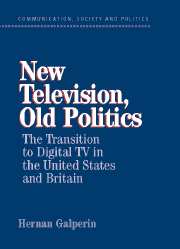Book contents
- Frontmatter
- Contents
- List of Figures and Tables
- Preface and Acknowledgments
- List of Acronyms and Abbreviations
- PART I A POLITICAL ECONOMY OF DIGITAL TV
- 1 Introduction
- 2 Why Digital TV?
- PART II THE AMERICAN ROAD TO DIGITAL TV
- PART III THE BRITISH ROAD TO DIGITAL TV
- PART IV NEW TELEVISION, OLD POLITICS
- References
- Index
1 - Introduction
from PART I - A POLITICAL ECONOMY OF DIGITAL TV
Published online by Cambridge University Press: 24 July 2009
- Frontmatter
- Contents
- List of Figures and Tables
- Preface and Acknowledgments
- List of Acronyms and Abbreviations
- PART I A POLITICAL ECONOMY OF DIGITAL TV
- 1 Introduction
- 2 Why Digital TV?
- PART II THE AMERICAN ROAD TO DIGITAL TV
- PART III THE BRITISH ROAD TO DIGITAL TV
- PART IV NEW TELEVISION, OLD POLITICS
- References
- Index
Summary
This book is about change in the television industry. It documents the transition from a world of spectrum scarcity, dumb terminals, and one-way services, to a world of on-demand programming, intelligent terminals, and abundant channels – namely, a transition from analog to digital TV. Heralded as the most important innovation in the history of the industry, digital TV involves the reconfiguration of a sector that, beyond its economic significance, is central to the mechanisms of democratic politics and the evolution of popular culture. This is certainly not the first time that the television industry faces reorganization on a massive scale. But for the most part past technological innovations have spurred evolutionary, not revolutionary change. An old black-and-white TV set would probably be able to pick up several color TV signals. Analog cable and satellite TV largely brought more (today, much more) of the same: branded packages of programming called channels. The transition to digital TV is different. It requires a complete retooling of the existing video production and distribution infrastructure, from studio cameras to transmission towers. It requires new mechanisms to compensate content creators and distributors in a world where conventional ads can be skipped and perfect copies made and distributed with the click of a button. And it requires new tools for viewers to navigate the maze of programming and new services available, much like Internet browsers help us find our way through the World Wide Web.
- Type
- Chapter
- Information
- New Television, Old PoliticsThe Transition to Digital TV in the United States and Britain, pp. 3 - 24Publisher: Cambridge University PressPrint publication year: 2004

